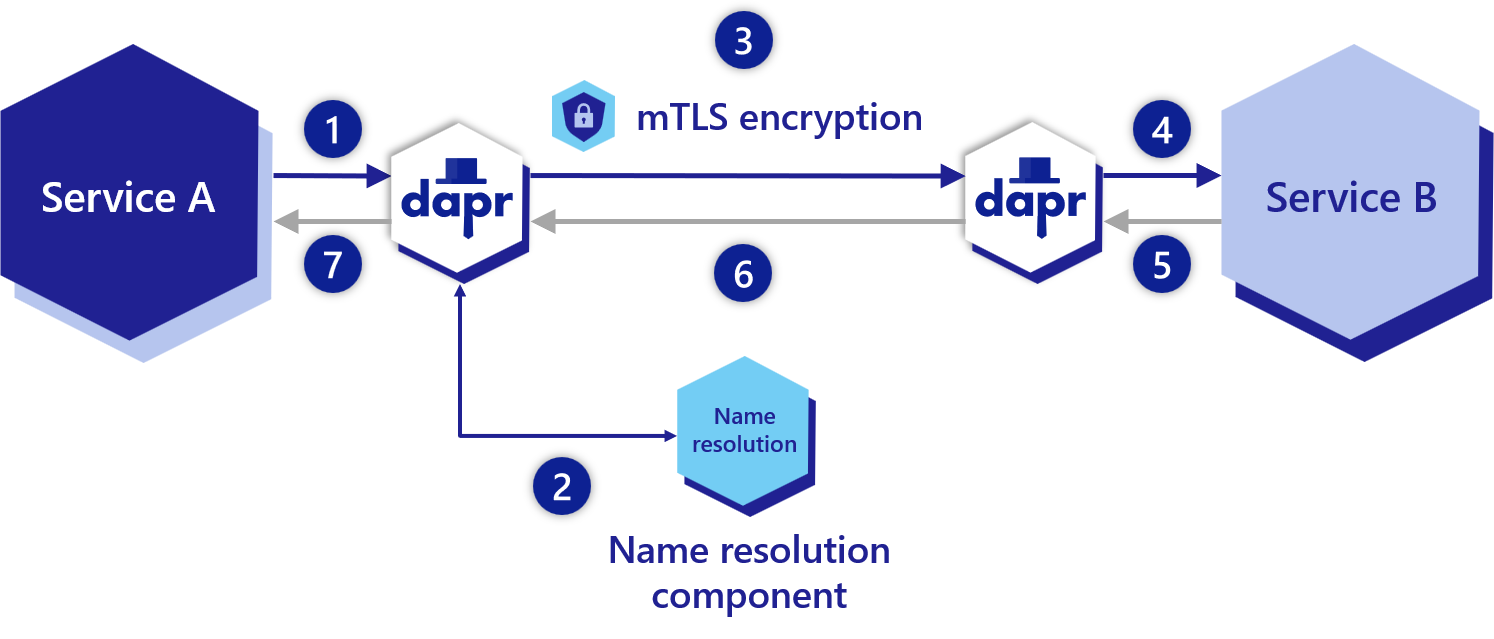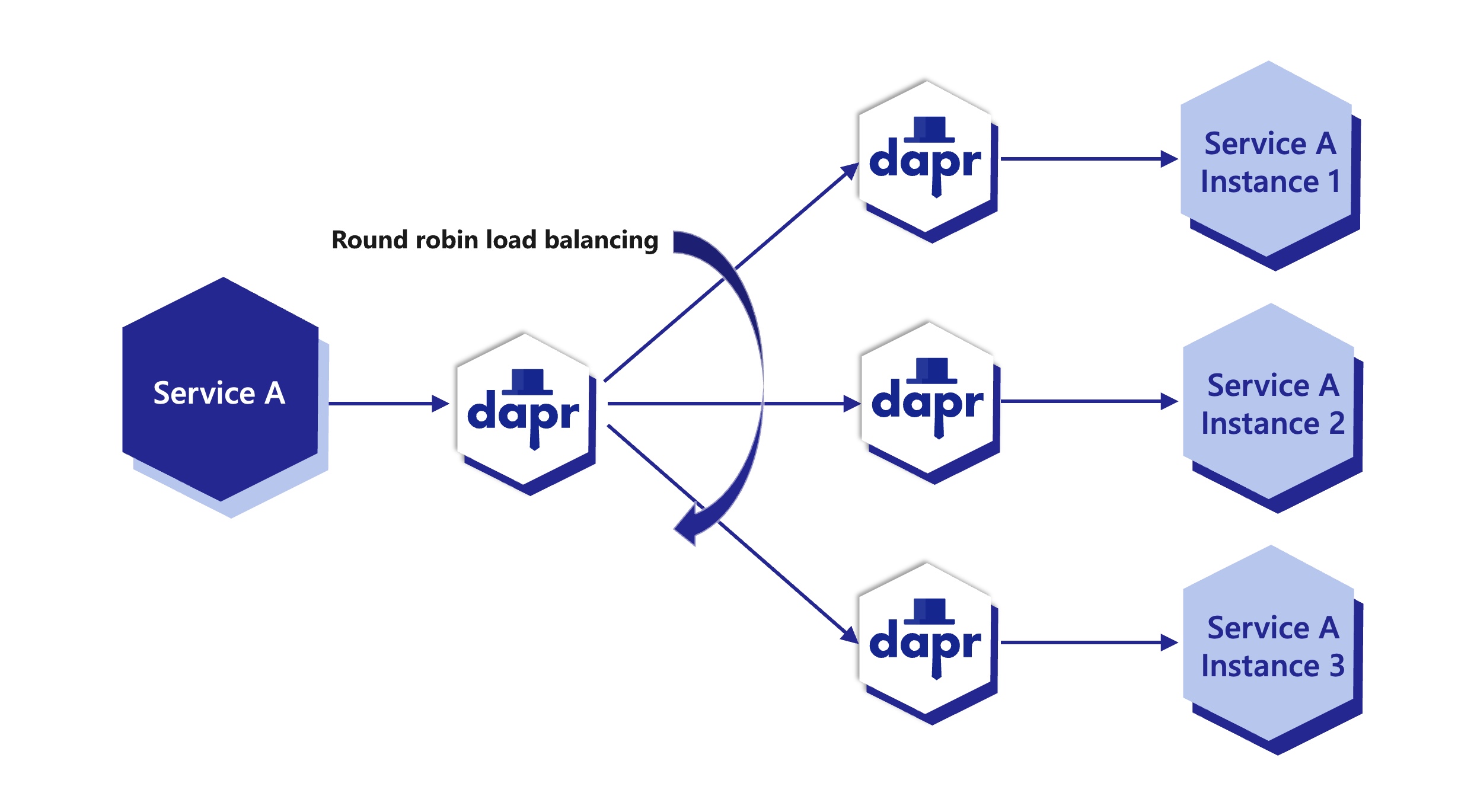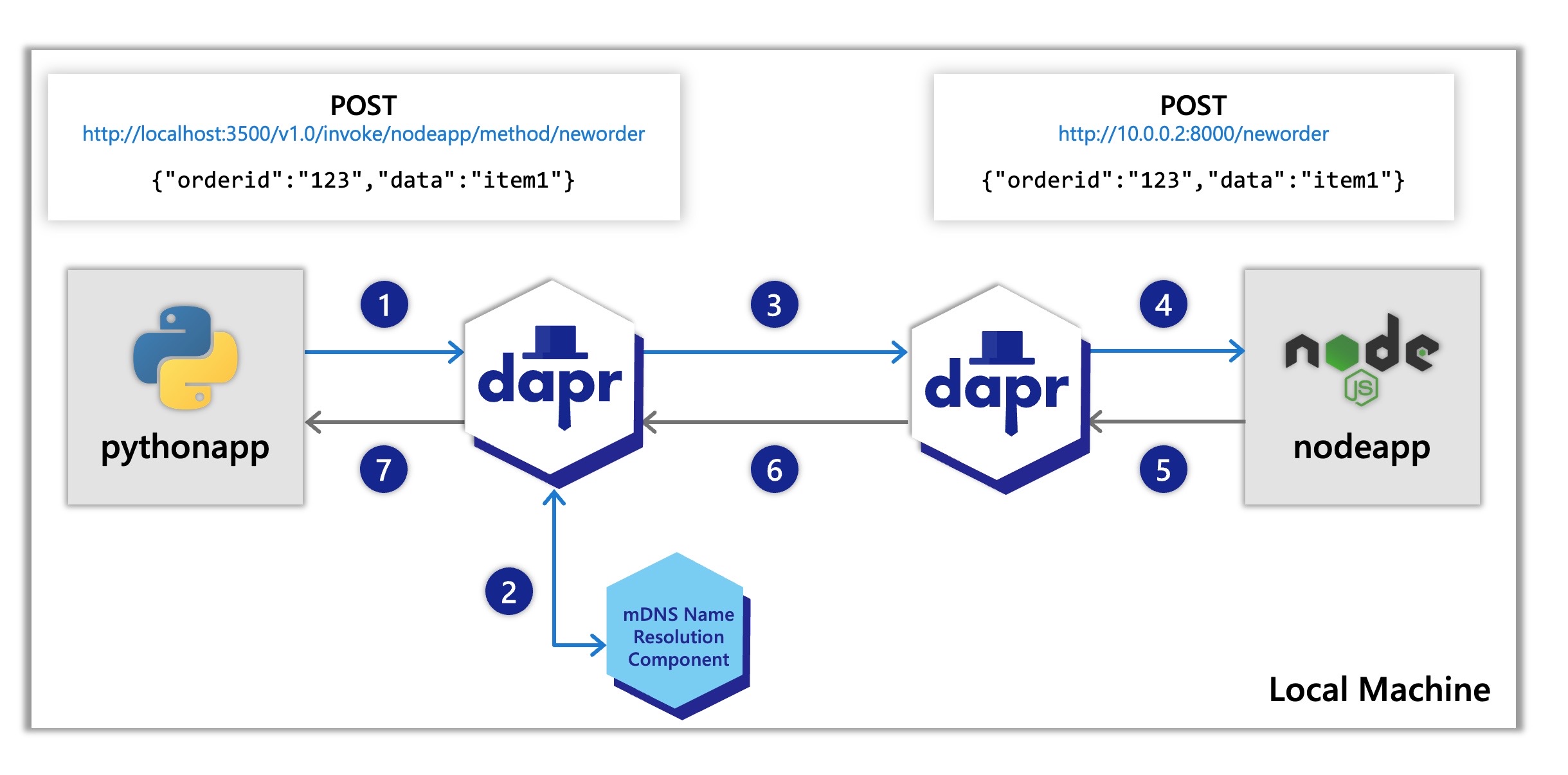The documentation you are viewing is for Dapr v1.7 which is an older version of Dapr. For up-to-date documentation, see the latest version.
Service invocation overview
Introduction
Using service invocation, your application can reliably and securely communicate with other applications using the standard gRPC or HTTP protocols.
In many microservice-based applications multiple services need the ability to communicate with one another. This inter-service communication requires that application developers handle problems like:
- Service discovery. How do I discover my different services?
- Standardizing API calls between services. How do I invoke methods between services?
- Secure inter-service communication. How do I call other services securely with encryption and apply access control on the methods?
- Mitigating request timeouts or failures. How do I handle retries and transient errors?
- Implementing observability and tracing. How do I use tracing to see a call graph with metrics to diagnose issues in production?
Dapr addresses these challenges by providing a service invocation API that acts similar to a reverse proxy with built-in service discovery, while leveraging built-in distributed tracing, metrics, error handling, encryption and more.
Dapr uses a sidecar architecture. To invoke an application using Dapr:
- You use the
invokeAPI on the Dapr instance. - Each application communicates with its own instance of Dapr.
- The Dapr instances discover and communicate with each other.
Service invocation diagram
The diagram below is an overview of how Dapr’s service invocation works.

- Service A makes an HTTP or gRPC call targeting Service B. The call goes to the local Dapr sidecar.
- Dapr discovers Service B’s location using the name resolution component which is running on the given hosting platform.
- Dapr forwards the message to Service B’s Dapr sidecar
- Note: All calls between Dapr sidecars go over gRPC for performance. Only calls between services and Dapr sidecars can be either HTTP or gRPC.
- Service B’s Dapr sidecar forwards the request to the specified endpoint (or method) on Service B. Service B then runs its business logic code.
- Service B sends a response to Service A. The response goes to Service B’s sidecar.
- Dapr forwards the response to Service A’s Dapr sidecar.
- Service A receives the response.
Features
Service invocation provides several features to make it easy for you to call methods between applications.
HTTP and gRPC service invocation
- HTTP: If you’re already using HTTP protocols in your application, using the Dapr HTTP header might be the easiest way to get started. You don’t need to change your existing endpoint URLs; just add the
dapr-app-idheader and you’re ready to go. For more information, see Invoke Services using HTTP. - gRPC: Dapr allows users to keep their own proto services and work natively with gRPC. This means that you can use service invocation to call your existing gRPC apps without having to include any Dapr SDKs or include custom gRPC services. For more information, see the how-to tutorial for Dapr and gRPC.
Service-to-service security
With the Dapr Sentry service, all calls between Dapr applications can be made secure with mutual (mTLS) authentication on hosted platforms, including automatic certificate rollover.
For more information read the service-to-service security article.
Resiliency including retries
In the event of call failures and transient errors, service invocation provides a resiliency feature that performs automatic retries with backoff time periods. To find out more, see the Resiliency article here.
Tracing and metrics with observability
By default, all calls between applications are traced and metrics are gathered to provide insights and diagnostics for applications. This is especially important in production scenarios, providing call graphs and metrics on the calls between your services. For more information read about observability.
Access control
With access policies, applications can control:
- Which applications are allowed to call them.
- What applications are authorized to do.
For example, you can restrict sensitive applications with personnel information from being accessed by unauthorized applications. Combined with service-to-service secure communication, you can provide for soft multi-tenancy deployments.
For more information read the access control allow lists for service invocation article.
Namespace scoping
You can scope applications to namespaces for deployment and security and call between services deployed to different namespaces. For more information, read the Service invocation across namespaces article.
Round robin load balancing with mDNS
Dapr provides round robin load balancing of service invocation requests with the mDNS protocol, for example with a single machine or with multiple, networked, physical machines.
The diagram below shows an example of how this works. If you have 1 instance of an application with app ID FrontEnd and 3 instances of application with app ID Cart and you call from FrontEnd app to Cart app, Dapr round robins’ between the 3 instances. These instance can be on the same machine or on different machines. .

Note: App ID is unique per application, not application instance. Regardless how many instances of that application exist (due to scaling), all of them will share the same app ID.
Pluggable service discovery
Dapr can run on a variety of hosting platforms. To enable service discovery and service invocation, Dapr uses pluggable name resolution components. For example, the Kubernetes name resolution component uses the Kubernetes DNS service to resolve the location of other applications running in the cluster. Self-hosted machines can use the mDNS name resolution component. The Consul name resolution component can be used in any hosting environment, including Kubernetes or self-hosted.
Example Architecture
Following the above call sequence, suppose you have the applications as described in the Hello World tutorial, where a python app invokes a node.js app. In such a scenario, the python app would be “Service A” , and a Node.js app would be “Service B”.
The diagram below shows sequence 1-7 again on a local machine showing the API calls:

- The Node.js app has a Dapr app ID of
nodeapp. The python app invokes the Node.js app’snewordermethod by POSTinghttp://localhost:3500/v1.0/invoke/nodeapp/method/neworder, which first goes to the python app’s local Dapr sidecar. - Dapr discovers the Node.js app’s location using name resolution component (in this case mDNS while self-hosted) which runs on your local machine.
- Dapr forwards the request to the Node.js app’s sidecar using the location it just received.
- The Node.js app’s sidecar forwards the request to the Node.js app. The Node.js app performs its business logic, logging the incoming message and then persist the order ID into Redis (not shown in the diagram).
- The Node.js app sends a response to the Python app through the Node.js sidecar.
- Dapr forwards the response to the Python Dapr sidecar.
- The Python app receives the response.
Try out service invocation
Quickstarts & tutorials
The Dapr docs contain multiple quickstarts that leverage the service invocation building block in different example architectures. To get a straight-forward understanding of the service invocation api and it’s features we recommend starting with our quickstarts:
| Quickstart/tutorial | Description |
|---|---|
| Service invocation quickstart | This quickstart gets you interacting directly with the service invocation building block. |
| Hello world tutorial | This tutorial shows how to use both the service invocation and state management building blocks all running locally on your machine. |
| Hello world kubernetes tutorial | This tutorial walks through using Dapr in kubernetes and covers both the service invocation and state management building blocks as well. |
Start using service invocation directly in your app
Want to skip the quickstarts? Not a problem. You can try out the service invocation building block directly in your application to securely communicate with other services. After Dapr is installed, you can begin using the service invocation API in the following ways.
Invoke services using:
- HTTP and gRPC service invocation (recommended set up method)
- HTTP - Allows you to just add the
dapr-app-idheader and you’re ready to get started. Read more on this here, Invoke Services using HTTP. - gRPC - For gRPC based applications, the service invocation API is also available. Run the gRPC server, then invoke services using the Dapr CLI. Read more on this in Configuring Dapr to use gRPC and Invoke services using gRPC.
- HTTP - Allows you to just add the
- Direct call to the API - In addition to proxying, there’s also an option to directly call the service invocation API to invoke a GET endpoint. Just update your address URL to
localhost:<dapr-http-port>and you’ll be able to directly call the API. You can also read more on this in the Invoke Services using HTTP docs linked above under HTTP proxying. - SDKs - If you’re using a Dapr SDK, you can directly use service invocation through the SDK. Select the SDK you need and use the Dapr client to invoke a service. Read more on this in Dapr SDKs.
For quick testing, try using the Dapr CLI for service invocation:
- Dapr CLI command - Once the Dapr CLI is set up, use
dapr invoke --method <method-name>command along with the method flag and the method of interest. Read more on this in Dapr CLI.
Next steps
- Read the service invocation API specification. This reference guide for service invocation describes how to invoke methods on other services.
- Understand the service invocation performance numbers.
- Take a look at observability. Here you can dig into Dapr’s monitoring tools like tracing, metrics and logging.
- Read up on our security practices around mTLS encryption, token authentication, and endpoint authorization.
Feedback
Was this page helpful?
Glad to hear it! Please tell us how we can improve.
Sorry to hear that. Please tell us how we can improve.